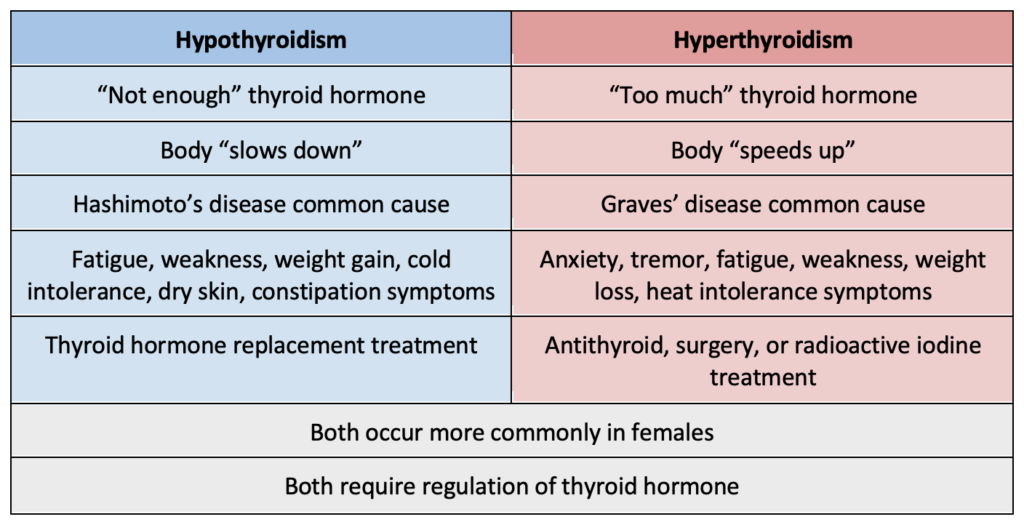The small, butterfly-shaped thyroid gland is in the neck and packs a punch when it comes to regulating the body’s metabolism. But what happens when it’s no longer balanced? What happens when it is working too hard or not hard enough? Let’s explore the difference between two common thyroid disorders- hypothyroidism and hyperthyroidism.

Hypothyroidism: An Underactive Thyroid
Hypothyroidism has to do with the thyroid’s inability to produce enough thyroid hormone.1 The most common cause of hypothyroidism is Hashimoto’s disease, an autoimmune disorder where antibodies attack the thyroid gland.2 There is a deficiency in the T4 hormone (thyroxine) that causes an elevation in thyroid-stimulating hormone (TSH). TSH regulates thyroid hormone production. Because of the deficiency, the body compensates by trying to produce more thyroid hormone, hence the elevated TSH. When T4 is low, the body slows down. This results in fatigue, weakness, weight gain, cold intolerance, dry skin, constipation, and so on.2 Hypothyroidism is more common than hyperthyroidism and occurs more often in females.
Hyperthyroidism: An Overactive Thyroid
On the other hand, hyperthyroidism is the complete opposite. The most common cause of hyperthyroidism is Graves’ disease which is also an autoimmune disorder where antibodies stimulate increased thyroid production of the T4 hormone.2 There is an increase in T4 hormone that causes TSH to be low. When T4 is high, the body speeds up. This results in anxiety, tremor, fatigue, weakness, weight loss, heat intolerance, frequent bowel movements, and so on.2 Hyperthyroidism is more common among females of older age.
Diagnosis and Treatment
Making an accurate diagnosis is crucial as both conditions involve the thyroid, and some symptoms may appear similar even though there is still a difference. Measuring thyroid hormone levels via laboratory blood tests will confirm diagnosis.
Treatment for hypothyroidism involves thyroid hormone replacement such as levothyroxine (Synthroid) or liothyronine (Cytomel), while treatment for hyperthyroidism involves antithyroid medication such as Propylthiouracil (PTU) or methimazole, surgery, or using radioactive iodine to destroy part of the gland.2
Pharmacists play a role in managing these disorders through collaboration with other healthcare providers. Such actions involve providing dosing guidance, counseling patients on medication usage and side effects, offering recommendations for symptom management, and addressing potential complications of not treating the disorder that could result in cardiovascular and fertility issues alike. They can also monitor drug interactions and educate patients on the importance of medication adherence.
In Summary
Hypothyroidism and hyperthyroidism- two sides of an imbalanced thyroid gland have a profound effect on the body. To understand and manage each condition, appropriate understanding is required as to what makes them different, what symptoms to watch out for, and how to treat each condition accordingly to achieve thyroid balance once more.

Midrara Kashmari
RxPharmacist Team
References:
- Hypothyroidism vs. hyperthyroidism: What’s the difference? NIH MedlinePlus Magazine. https://magazine.medlineplus.gov/article/hypothyroidism-vs-hyperthyroidism-whats-the-difference.
- Hyperthyroidism vs. Hypothyroidism: Here’s How to Tell The Difference | Hartford HealthCare | CT. hartfordhealthcare.org. https://hartfordhealthcare.org/about-us/news-press/news-detail?articleid=32994&publicId=395.

